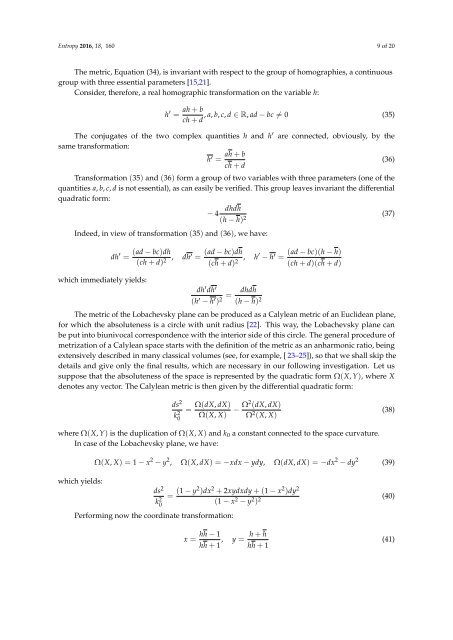entropy-18-00160
Create successful ePaper yourself
Turn your PDF publications into a flip-book with our unique Google optimized e-Paper software.
Entropy 2016, <strong>18</strong>, 160 9 of 20<br />
The metric, Equation (34), is invariant with respect to the group of homographies, a continuous<br />
group with three essential parameters [15,21].<br />
Consider, therefore, a real homographic transformation on the variable h:<br />
h ′ = ah + b , a, b, c, d ∈ R, ad − bc ̸= 0 (35)<br />
ch + d<br />
The conjugates of the two complex quantities h and h ′ are connected, obviously, by the<br />
same transformation:<br />
h ′ = ah + b<br />
(36)<br />
ch + d<br />
Transformation (35) and (36) form a group of two variables with three parameters (one of the<br />
quantities a, b, c, d is not essential), as can easily be verified. This group leaves invariant the differential<br />
quadratic form:<br />
− 4<br />
dhdh<br />
(37)<br />
(h − h) 2<br />
Indeed, in view of transformation (35) and (36), we have:<br />
dh ′ =<br />
(ad − bc)dh<br />
(ch + d) 2 , (ad − bc)dh<br />
dh′ =<br />
(ch + d) , 2 h′ − h ′ (ad − bc)(h − h)<br />
=<br />
(ch + d)(ch + d)<br />
which immediately yields:<br />
dh ′ dh ′<br />
(h ′ − h ′ ) 2 = dhdh<br />
(h − h) 2<br />
The metric of the Lobachevsky plane can be produced as a Calylean metric of an Euclidean plane,<br />
for which the absoluteness is a circle with unit radius [22]. This way, the Lobachevsky plane can<br />
be put into biunivocal correspondence with the interior side of this circle. The general procedure of<br />
metrization of a Calylean space starts with the definition of the metric as an anharmonic ratio, being<br />
extensively described in many classical volumes (see, for example, [23–25]), so that we shall skip the<br />
details and give only the final results, which are necessary in our following investigation. Let us<br />
suppose that the absoluteness of the space is represented by the quadratic form Ω(X, Y), where X<br />
denotes any vector. The Calylean metric is then given by the differential quadratic form:<br />
ds 2<br />
k 2 0<br />
=<br />
Ω(dX, dX)<br />
Ω(X, X)<br />
− Ω2 (dX, dX)<br />
Ω 2 (X, X)<br />
(38)<br />
where Ω(X, Y) is the duplication of Ω(X, X) and k 0 a constant connected to the space curvature.<br />
In case of the Lobachevsky plane, we have:<br />
which yields:<br />
Ω(X, X) = 1 − x 2 − y 2 , Ω(X, dX) = −xdx − ydy, Ω(dX, dX) = −dx 2 − dy 2 (39)<br />
ds 2<br />
k 2 0<br />
Performing now the coordinate transformation:<br />
= (1 − y2 )dx 2 + 2xydxdy + (1 − x 2 )dy 2<br />
(1 − x 2 − y 2 ) 2 (40)<br />
x = hh − 1<br />
hh + 1 ,<br />
y = h + h<br />
hh + 1<br />
(41)



